|
|
|
Sort Order |
|
|
|
Items / Page
|
|
|
|
|
|
|
| Srl | Item |
| 1 |
ID:
001748
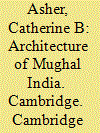

|
|
|
|
|
| Publication |
Cambridge, Cambridge University Press, 1995.
|
| Description |
xxxi, 368p.Hbk
|
| Series |
New Cambridge Hisotry of India
|
| Standard Number |
81-85618-69-0
|
|
|
|
|
|
|
|
|
|
|
|
Copies: C:1/I:0,R:0,Q:0
Circulation
| Accession# | Call# | Current Location | Status | Policy | Location |
| 042364 | 720.954/ASH 042364 | Main | On Shelf | General | |
|
|
|
|
| 2 |
ID:
126135
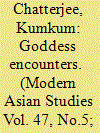

|
|
|
|
|
| Publication |
2013.
|
| Summary/Abstract |
This paper makes a case for exploring the cultural facets of Mughal rule as well as for a stronger engagement with sources in vernacular languages for the writing of Mughal history. Bengal's regional tradition of goddess worship is used to explore the cultural dimensions of Mughal rule in that region as well as the idioms in which Bengali regional perceptions of Mughal rule were articulated. Mangalkavya narratives-a quintessentially Bengali literary genre-are studied to highlight shifting perceptions of the Mughals from the late sixteenth century to the eighteenth century. During the period of the Mughal conquest of Bengal, the imperial military machine was represented as a monster whom the goddess Chandi, symbolizing Bengal's regional culture, had to vanquish. By the eighteenth century, when their rule had become much more regularized, the Mughals were depicted as recognizing aspects of Bengal's regional culture by capitulating in the end to the goddess and becoming her devotees. This paper also studies the relationship of the Mughal regime with Bengal's popular cultural celebration-the annual Durga puja-and explores its implications for the public performance of religion and for community formation during the early modern period.
|
|
|
|
|
|
|
|
|
|
|
|
|
|
|
|
| 3 |
ID:
128781
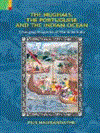

|
|
|
|
|
| Publication |
DelhI, Primus Books, 2013.
|
| Description |
viii, 234p.Hbk
|
| Standard Number |
9789380607337
|
|
|
|
|
|
|
|
|
|
|
|
Copies: C:1/I:0,R:0,Q:0
Circulation
| Accession# | Call# | Current Location | Status | Policy | Location |
| 057670 | 954/MAL 057670 | Main | On Shelf | General | |
|
|
|
|
| 4 |
ID:
089360
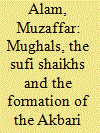

|
|
|
|
|
| Publication |
2009.
|
| Summary/Abstract |
This essay places Mughal-Sufi relationship within a larger sixteenth century context, focusing on the strategies the early Mughals adopted to build their power in India. It reviews the positions of the two important sufi groups, the Indian Chishtis and the Central Asian Naqshbandis, juxtaposing the political benefits or the loss that the Mughals saw in their associations with them. While the Naqshbandi worldview and the legacy of the legendary Ubaid Allah Ahrar clashed with their vision of power, in the Chishti ideology, on the other hand, they found a strong support for themselves. The Chishtis then had an edge at the time of Akbar. But the Naqshbandis under Khwaja Baqi Billah (d. 1603) continued in their endeavour to reinstate their place in Mughal India. The paper thus provides a backdrop and makes a plea for re-evaluating the debate on the ideology and politics of Shaikh Ahmad Sirhindi (d. 1624).
|
|
|
|
|
|
|
|
|
|
|
|
|
|
|
|
| 5 |
ID:
139460
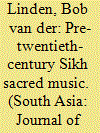

|
|
|
|
|
| Summary/Abstract |
This article discusses the canonisation and institutionalisation of Sikh sacred music (kirtan) at the courts of the ten Sikh gurus and the later Sikh maharajas in Lahore and Patiala. At the same time, it emphasises possible parallels with what happened musically at the Mughal court. Essentially, the article argues that pre-twentieth-century Sikh sacred music was Hindustani (classical) music because of its performance practice, instruments used, music theory and the interactions between Sikh court musicians and those of the Mughal and other North Indian courts, as well as of different Hindustani music lineages (gharanas). Ultimately, it underlines the importance of contextual history, for example in terms of Mughal culture, the imperial encounter and globalisation, in forming a firm understanding of continuity and change over five centuries of kirtan performance practice.
|
|
|
|
|
|
|
|
|
|
|
|
|
|
|
|
| 6 |
ID:
101355
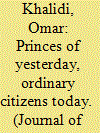

|
|
|
| 7 |
ID:
184158
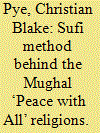

|
|
|
|
|
| Summary/Abstract |
The mystical method of taḥqīq (‘realization’ or ‘verification’ of divine truth), as promoted by the Andalusian thinker Ibn ‘Arabi (d. 1240), was central to the project of managing religious difference in the Mughal empire. The key architect of deploying taḥqīq for imperial purposes was emperor Akbar's senior minister, ideologue, and spiritual devotee, Abu al-Fazl. Specifically, I analyse how the concept of taḥqīq appears in Abu al-Fazl's 1587 preface to the Razmnāma (‘Book of War’), the first translation into Persian of the Sanskrit religious epic Mahābhārata. The Mughal Razmnāma was a monumental achievement, the foremost product of Akbar's push to translate non-Islamic religious works into Persian. In its elaborate preface, Abu al-Fazl clearly outlines that this translation was an exercise in taḥqīq, made possible by a sovereign who had achieved spiritual perfection, and he calls the Mughal empire a ‘Caliphate of Taḥqīq’. As such, this study bridges two scholarly conversations which have been previously distinct. One is the renewed focus in Islamic studies on Ibn ‘Arabi's ideas, specifically on taḥqīq in the late medieval and early modern periods across the Islamic world. The other is the recent interest in Mughal historiography on ṣulḥ-i kull (Total Peace). This article positions Ibn ‘Arabi's taḥqīq within an elite Persianate intellectual milieu that carried the concept to Mughal South Asia, and it demonstrates, through an analysis of the Razmnāma's preface, that taḥqīq was politicized by Abu al-Fazl and Akbar to develop the imperial policy of managing religious difference, which came to be known as ṣulḥ-i kull.
|
|
|
|
|
|
|
|
|
|
|
|
|
|
|
|
| 8 |
ID:
162465
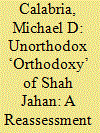

|
|
|
|
|
| Summary/Abstract |
In spite of the many beautiful works of art and architecture produced under the patronage of the Mughal emperor Shah Jahan (r. 1628–58 CE), including the incomparable Taj Mahal, historians have not generally been kind to him. In scholarship both past and present, he is often compared unfavourably with his grandfather, Akbar, and his father, Jahangir, described pejoratively as an ‘orthodox’ Muslim whose reign was characterised by a stricter adherence to shari‘a and religious intolerance of Hindus and Christians. This article re-examines recurrent issues in the historiography of Shah Jahan's life and rule, his religious views and his attitudes towards Hindus, Jains, Christians and Sufis. Based on a diversity of historical and art historical sources, it concludes that the so-called evidence for his ‘orthodoxy’ has been largely misconstrued. This is perhaps due in part to the inflated rhetoric of royal chronicles and colonial critics, as well as to post-Partition prejudice against Islam.
|
|
|
|
|
|
|
|
|
|
|
|
|
|
|
|
|
|
|
|
|